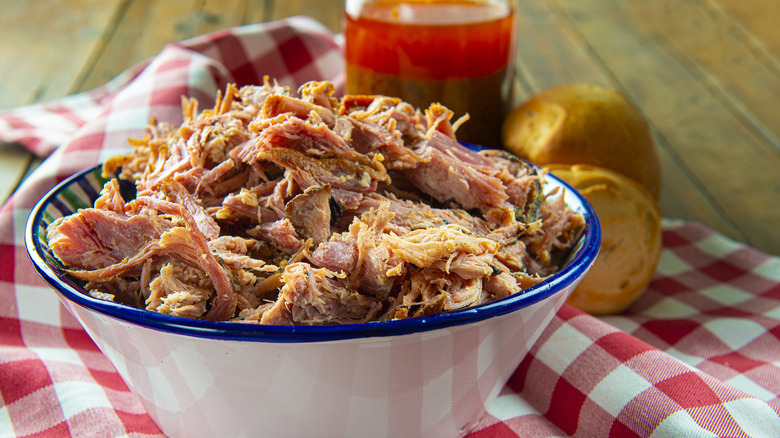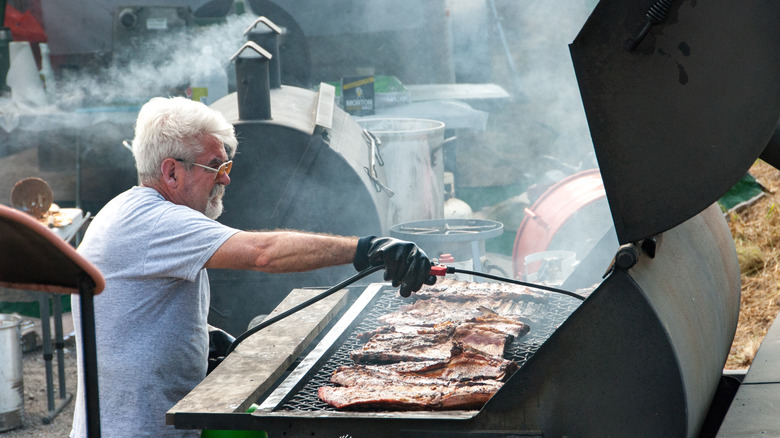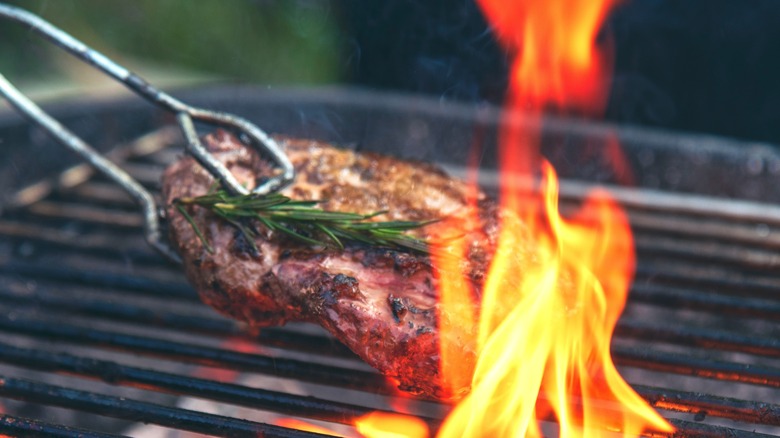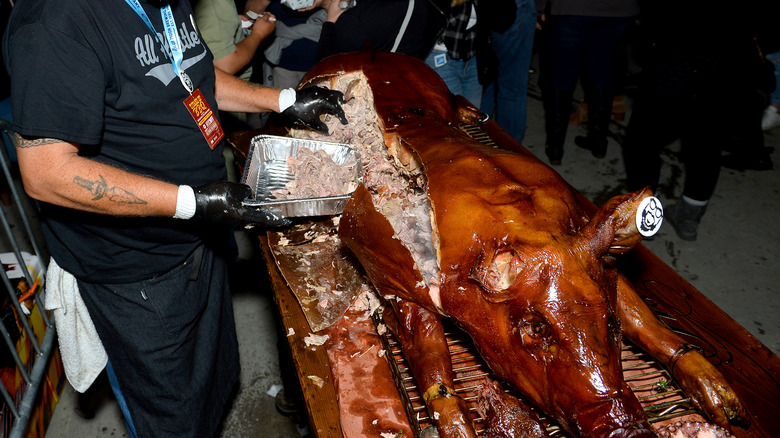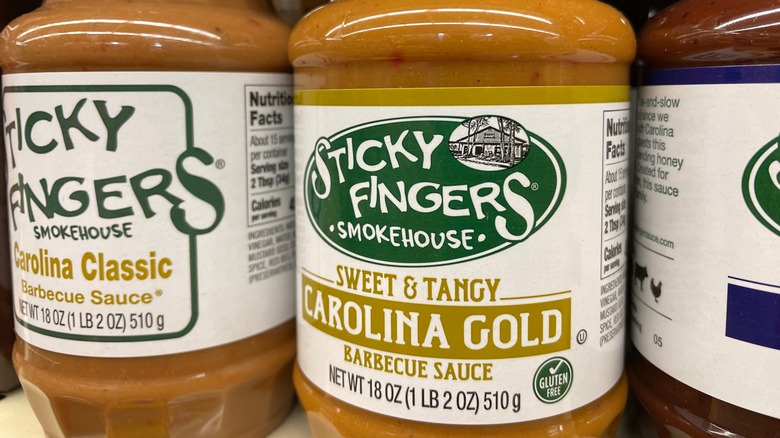North Vs South Carolina: What Makes These Barbecue Experiences Different?
Humanity has been roasting its food over an open fire for millennia, but barbecue has a special place in many of our hearts. With its bold, tangy flavors and perfectly tender meats, it's difficult for anyone to say no to a plate of good old barbecue. Although barbecue has historical roots that date back farther than the United States itself, the Carolinas are often considered the birthplace of modern American barbecue.
Nestled against the Atlantic coastline and pockmarked by the Appalachian Mountains, North and South Carolina provide the perfect backdrop for good slow cooking. There are many styles of regional barbecue in the U.S., but Carolina barbecue remains a central force on the scene. Although we're talking about Carolina barbecue in general, the truth is that the region is even more divided on how to cook barbecue than simply North and South. Taken altogether, there are six different styles of barbecue in the Carolinas: two in the north and four in the south. But not to worry, we'll sort it all out for you here. Whether you're a Carolina native looking to dig deeper into the local culinary scene or a distant observer hoping to find inspiration for your own barbecue pit, the many flavors and varieties of Carolina barbecue are an iconic testament to the foodie soul that lives in us all.
What is North Carolina barbecue?
North Carolina barbecue is separated into two distinct groups: East North Carolina barbecue is the wise older brother to West North Carolina's fast and loose style, having been around a bit longer. There's a lot we could say about North Carolina barbecue, but the important part is what it tastes like. Although there are a number of differences between them, the contrast in sauce preference between East and West North Carolina is arguably the most important.
East North Carolina barbecue is typified by a vinegar-based barbecue sauce, which adds a simple but savory profile to the meat. Like all barbecue in the Carolinas, pork is the meat of choice. West North Carolina barbecue uses ketchup as the base for its barbecue sauce, giving it a slightly sweeter and more viscous flavor profile. West North Carolina barbecue is relatively saucy compared to the Eastern style, but you could just as easily spin that same factoid around and say that East North Carolina barbecue is dry — not in the sense of being overcooked, but in the sense of using less sauce).
You'll often hear West North Carolina barbecue referred to as Lexington-style or Piedmont-style barbecue. Whatever you call it, it's referring to North Carolina barbecue that uses ketchup as its base. So do these two North Carolina barbecue styles have something in common that separates them from South Carolina barbecue? Yes and no.
What is South Carolina barbecue?
South Carolina barbecue has some high profile fans, and for good reason. Pork is still king here, but the sauce and preparation differ somewhat from the North. When people think of South Carolina barbecue, most of them will think of Carolina Gold barbecue sauce, which is mustard-based. There are actually four different styles of South Carolina barbecue sauce, and the four styles of South Carolina barbecue largely fall along the fault lines of which sauce is being used.
Carolina Gold barbecue sauce is typically associated with Central South Carolina barbecue. East South Carolina barbecue (also known as the Pee Dee region) mimics East North Carolina barbecue with a similar (though not identical) vinegar-based sauce. The Midlands use a light ketchup-based sauce, while West South Carolina barbecue also uses ketchup as a base but is a bit heavier on the ketchup.
Getting a firm grip of the regional differences between North and South Carolina barbecue is difficult enough, and these subregional styles make the endeavor all the more complicated, but the dense knot that is Carolina barbecue is, in fact, understandable if you take it piece by piece. Granted, you could fill an entire book on the topic, and people have, but if we break it down little by little, we can get the gist in shorter time. The two main factors, as you may have already guessed, are the meat and the sauce.
The Carolinas both use pork in their barbecue, but not in the same way
It's a well-known fact that pork reigns supreme in Carolina barbecue. More than supreme, really, because it stands alone as the only meat Carolina barbecue makes use of. What's different between the various regional styles is which cut of pork they prefer to cook with. East North Carolina and Pee Dee barbecue both utilize the whole hog. This type requires long cook times (upwards of 18 hours sometimes) to thoroughly cook the entire pig.
Lexington style barbecue is particularly fond of smoked pork shoulder, which is much simpler to cook than the whole hog; or, if not simpler, it's certainly quicker. When South Carolinians aren't cooking up the whole hog, they're following suit with Lexington style by smoking either pork shoulder or ham.
All throughout the Carolinas, hickory and oak wood are the preferred source of fuel and flavorful smoke. When cooking the entire animal, concrete pits are a common tool. Techniques may differ, but a typical pit will consist of concrete bricks stacked on top of each other with an empty area on the bottom for the fire, a metal rack in the middle to hold the hog, and corrugated metal or some other type of material used to cover the top and keep the heat in. For smaller cuts, like Lexington style pork shoulder, a more typical grill or smoker can be use, though individual preferences can and do vary.
The sauce is the boss when it comes to Carolina barbecue
Although the meat is the main attraction, it's really the barbecue sauce that differentiates the various Carolina barbecue styles. There are three core barbecue sauce variations: vinegar, tomato, and mustard. When barbecue was first making its way to the Carolinas from the Caribbean, lemon or lime juice was a popular ingredient in the sauce. Because lemons and limes weren't readily available in the region, Carolinians used vinegar instead. East North Carolina barbecue and Pee Dee barbecue have both retained this historic sauce style, though Pee Dee barbecue omits the sugar, which gives their sauce a little more of a spicy kick.
If you've ever seen golden-yellow barbecue sauce, then you're familiar with mustard-based barbecue sauce, which was popularized by South Carolina's central region. This sauce has varying levels of sweetness to it, but the really good stuff has that pungent mustard pop that we all know and love. Then, there are the tomato-based barbecue sauces, which usually feature tomatoes in the form of ketchup. Different sauces will have a thinner or thicker viscosity depending on the recipe, and the thickness of the sauce is specific to different regions. For example, Lexington style sauce is a thinner version relative to Western South Carolina. These tomato-based barbecue sauces are more akin to the kinds of barbecue sauce we typically find elsewhere around the country. Whatever sauce you pick, Carolina barbecue goes great with a pint of black lager.
